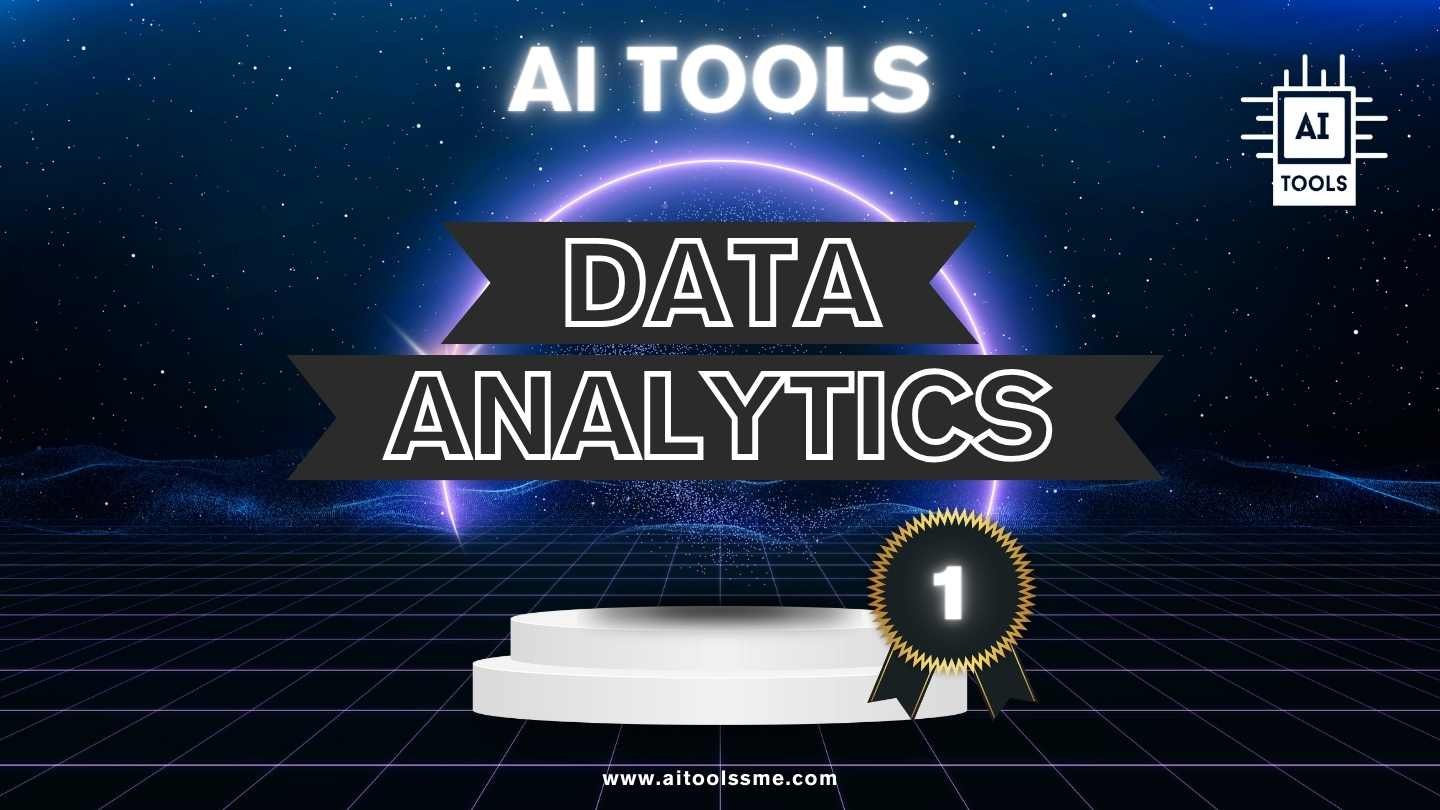The 10 Best AI Data Analytics Tools for 2025
The new kids on the block are outplaying the long-established by far
Written by
Last updated

Hasan Shaukat
August 23rd, 2024

Data analysis lays the groundwork for improving operations, understanding customer behaviour, and optimizing strategies for growth based on your collected data.
AI data analytics tools suggest angles for analysis and learn with you as you go, like the software from polymer.
Unsure which metric to use on which axis? Just ask ChatGPT, it’s a great data analytics AI assistant.
Also, our review contains a few affiliate marketing links. If you purchase any of the tools, we might receive a small commission.

Spoiler Alert
AI is now running SQL queries and python scripts on our data.
In some platforms it gives visual outputs along with an explanation, in others it gives a natural language response to our questions.
AI driven data analytics landscape is ready to use for small businesses, and can be used as part of analytics for large businesses. It's only a matter of time when these platforms will do no code prompt-based analytics at scale for large companies.
The big players like PowerBI, Tableau, Looker, though not yet equipped with AI, will soon include AI chat assistants and will change the data analytics landscape once again.
We still made an effort and compared those big companies to new up and coming AI data analytics stars on the horizon like Polymer or Julius AI in our extensive review.
The Best AI-Powered Data Analytics Tools:

AI Data Analytics tool Comparison
1
AKKIO
Setup/Onboarding




 5/5
5/5
User Experience




 5/5
5/5
Tool Performance




 5/5
5/5
Overall score:
5/5
Use Cases
Give your agency a competitive edge with AI. Here are some ways that Akkio can help support your clients – from predictive analytics to automated reporting.
Support
Chatbot
Key Features
- Data Analysis
- Data Interaction
- Decision Making Modeling
- Data Visualizations
- Report Generation
- Generative AI Text Generation
- Collaborative editing in Reports by giving edit access
- Multiple reports within a project
- Shareable charts
- Integrated predictive models
- Powerful embedding feature
- Chat in Reports
- Enhanced sharing for Reports
- Insights in Reports
- Tabbed Reports
- Enhanced Sharing for Reports
- Embeddable Reports
- Insights in Reports
- Prompt Interpretation Visibility
- Detailed Chat Explanations
- Improved Text Responses
- Efficient Lead Scoring
- Quick Conversion Insights
- Rapid Ticket Forecasting
Pros & Cons
Pros:
- Natural language based data cleaning and wrangling
- Natural language based data cleaning and wrangling
- Able to understand metrics and automatically create derived metrics to answer questions
- Can give visualizations to answer questions. Each visual can be added to a dashboard
- Whitelabel your agency brand on the dashboard, chat, deployed model
Cons:
- Limited to one table per project/scenario
- Needs aggregate tables for best utilization
- Dashboarding section is primitive, underdeveloped
Price Point
Conclusion
A superb tool that does extensive data analyst and data scientist work just with natural language.
2
Polymer
Setup/Onboarding




 5/5
5/5
User Experience




 5/5
5/5
Tool Performance




 4/5
4/5
Overall score:
4.75/5
Use Cases
Ideal for small businesses. Create visualizations, build dashboards, and present your data like a pro — in minutes. Super easy data integration saves nerves and time.
Support
1:1 onboarding session
Key Features
- Reusable custom elements
- AI suggestions for analysis
- Data binding
- Component-based architecture
- Board designer
- Embedded Analytics
Pros & Cons
Pros:
- AI suggested dashboard auto creation
- AI chat in the dashboard page answers questions and gives suggestions for further visuals
Cons:
- Lack of depth, can't create derived metrics on it's own to answer questions
Price Point
Conclusion
A great tool for a small business to monitor performance and understand from data

3
Julius AI
Setup/Onboarding




 5/5
5/5
User Experience




 5/5
5/5
Tool Performance




 3/5
3/5
Overall score:
4.25/5
Use Cases
Streamlines customer support operations by automating responses to common queries through natural language understanding and machine learning, improving response time and efficiency.
Support
Chat
Key Features
- Natural Language Processing (NLP)
- Data Analysis and Insights
- Personalized Recommendations
- Automation and Task Management
- Predictive Analytics
- Integration with External Systems
- Customizable Workflows
- Analyze Datasets
- Create charts and plots
- perform computations
- apply statistical methods like regression, forecasting, PCA
Pros & Cons
Pros:
- Able to make detailed visualizations upon user request
Cons:
- No holistic dashboarding
- Conversational AI sometimes give wrong answer compared to the visualization
Price Point
Conclusion
A good tool for an analyst for deep-dive analyses Also available as a plugin on ChatGPT Plugins "Chat with your Data"
*** Discount *** Get 10% off on all payments with Code: LILI
interview with Rahul Sonwalkar, CEO of Julius AI

Any tips, tricks or hacks regarding the use of AI?
Prompt like you are speaking to a human with no context of what is going on. Don't assume the models can read your mind! We often see this with Julius — the biggest struggle is getting users to explain their tasks thoroughly, without leaving out or skipping over key details.
4
ZOHO ANALYTICS
Setup/Onboarding




 5/5
5/5
User Experience




 4/5
4/5
Tool Performance




 3/5
3/5
Overall score:
4/5
Use Cases
Connect, prepare, analyze your data, and get deep, actionable insights.
Support
Community Forums, Knowledge base
Key Features
- Data Preparation and Management
- Visual Analysis
- Augmented Analytics
- Unified Business Insights
- Collaborative Analytics
- Data Storytelling
- Embedded BI
- Mobility
- Deployments
Pros & Cons
Pros:
- Easy setup
- Default dashboards are good for basic analytics
Cons:
- Chat based information retrieval is trivial, not LLM based
- AI can't go beyond basic aggregations
Price Point
Conclusion
A good tool for basic dashboarding for non-technical people, especially when they're using the rest of the Zoho Suite
5
Setup/Onboarding




 3/5
3/5
User Experience




 4/5
4/5
Tool Performance




 5/5
5/5
Overall score:
3.75 / 5
Use Cases
Ideal for marketing teams that require robust reporting and analytics capabilities to track the performance of their online marketing campaigns across various platforms.
Support
Help Center & Email support
Key Features
- Data integration and automation
- Connecting to various data sources
- Data transformation and cleansing
- Scheduled data imports
- Performance tracking and reporting
- Marketing dashboards
Pros & Cons
Pros:
- Ease of use
- Modular pricing
Cons:
- Integrations not always working
- Single plan very limited
Price Point
6
Setup/Onboarding




 3/5
3/5
User Experience




 4/5
4/5
Tool Performance




 4/5
4/5
Overall score:
3.75 / 5
Use Cases
For businesses that need to integrate data from multiple marketing sources seamlessly, so data from sources like advertising platforms, eCommerce, and web analytics is collected and organized efficiently.
Support
Help Center & Email support
Key Features
- Multi-channel data collection
- Data normalization and mapping
- Marketing attribution
- Automated data enrichment
- Customized reporting and analytics
- +500 integrations
- Data cleaning automation
Pros & Cons
Pros:
- Good customer support
Cons:
- No scheduling function
- Limited functionality across marketing services
Price Point
How do big players like Power BI, Looker and Tableau compare to the AI data analytics tools?
7
Setup/Onboarding




 1/5
1/5
User Experience




 3/5
3/5
Tool Performance




 3/5
3/5
Overall score:
2.25 / 5
Use Cases
Advanced data analytics tool for enterprises with solid but a bit outdated dashboards.
Front runner for AI innovation.
Support
Large variety for higher plans
Key Features
- Data visualization and exploration
- Interactive reports and dashboards
- Integration with Microsoft ecosystem
- Data modeling & transformation
- Natural language queries
Pros & Cons
Pros:
- Solid and high variety of features
Cons:
- Unspecified error messages
- Overall data complications
Price Point
8
Qlik
Setup/Onboarding




 2
2
User Experience




 2
2
Tool Performance




 1
1
Overall score:
1.75/5
Use Cases
As an analytics platform, Qlik facilitates real-time monitoring of key performance indicators, allowing organizations to quickly adapt to market changes and optimize operational performance.
Support
Customer support, Training & Webinars
Key Features
- Data Visualization
- Data Integration and Connectivity
- Advanced Analytics
- Collaboration and Sharing
- Mobile Access and Offline Analytics
- Security and Governance
- Qlik Answers
Pros & Cons
Pros:
- Capable of processing complex datasets
- Has data engineering and modeling ecosystem
Cons:
- No AI is being used to analyze data
- Very complex to navigate setup
Price Point
Conclusion
Still a traditional data analytics platform with a large overhead learning cost
9
Setup/Onboarding




 2/5
2/5
User Experience




 3/5
3/5
Tool Performance




 4/5
4/5
Overall score:
3 / 5
Use Cases
Advanced data analytics tool, ideal for enterprises and many collaborators seeking powerful data insights. Its extensive visualization capabilities make it a preferred choice for big businesses, provided users are willing to invest time and effort into mastering it.
Support
Large variety for higher plans
Key Features
- Data visualization
- Interactive dashboards
- Data exploration
- Integration with various data sources
- Collaborative analytics
- Automatic updates
- Smart Dashboards
- CRM analytics
Pros & Cons
Pros:
- Best data visualisation
Cons:
- Complex onboarding
Price Point
10
Setup/Onboarding




 1/5
1/5
User Experience




 2/5
2/5
Tool Performance




 2/5
2/5
Overall score:
1.75 / 5
Use Cases
Advanced data analytics tool, which requires data sets to be provided in an optimal way to work flawlessly.
Support
Large variety for higher plans
Key Features
- Data exploration and discovery
- Interactive dashboards
- Real-time analytics
- Data modeling & transformation
- Embedded analytics
Pros & Cons
Pros:
- ?
Cons:
- If data is not prepared the optimal way, very long loading times
- Colours not always assigned correctly
Price Point

About the author: Hasan Shaukat
A crazy nerd babbling about the outer space and quantum worlds, apart from that, a Marketing Data Scientist with 6 years of experience.
Hasan worked with web tracking data, customer and market response modeling, text mining, LLMs, and Data Products.
Connect with him on Linkedin if you like.
FAQ Data Analytics
What are the key considerations for selecting a data analytics tool?
When choosing a data analytics tool, the process is similar to selecting a smartphone - it should align with specific needs and offer ease of use. Here are a few key points to consider:
Data integration capabilities
User-friendliness
Scalability to grow with your business
What are some top analytics tools?
The selection of an analytics tool depends on requirements and objectives. Some businesses require tools for quick, visual reports, while others need robust systems to process large amounts of complex data. Leading solutions include Akkio with its no-code AI analytics, Polymer for intuitive dashboards and visualizations, and Julius AI for marketing-focused insights. The most suitable tool aligns with specific business needs.
What's the best data analytics software for small businesses?
Consider essential requirements – whether simplicity or advanced features are priorities. Factor in the time available for system learning and compatibility with existing business tools. For example, Polymer offers AI capabilities for automated analysis, while ZOHO Analytics integrates effectively with other Zoho products for connected operations.










